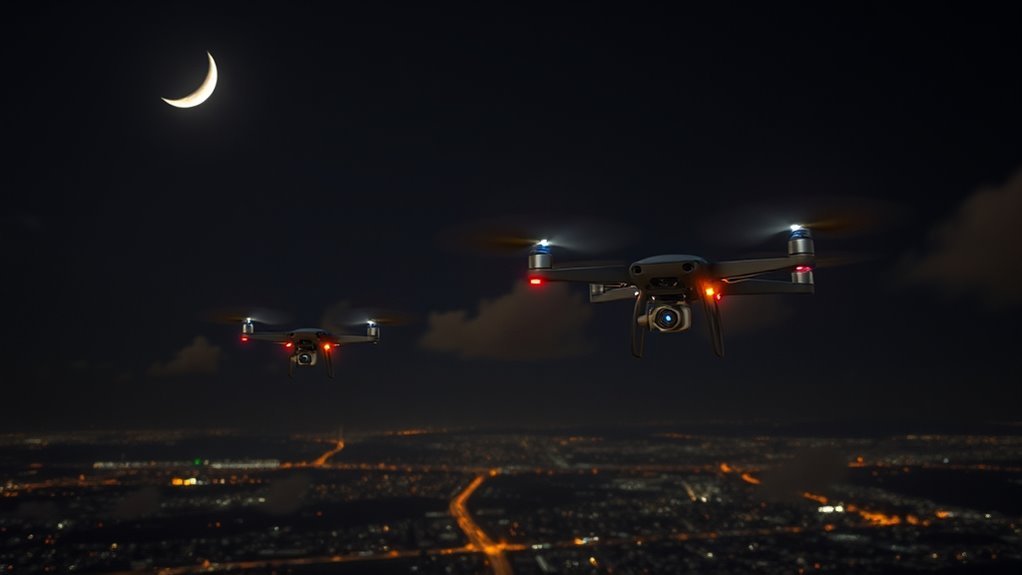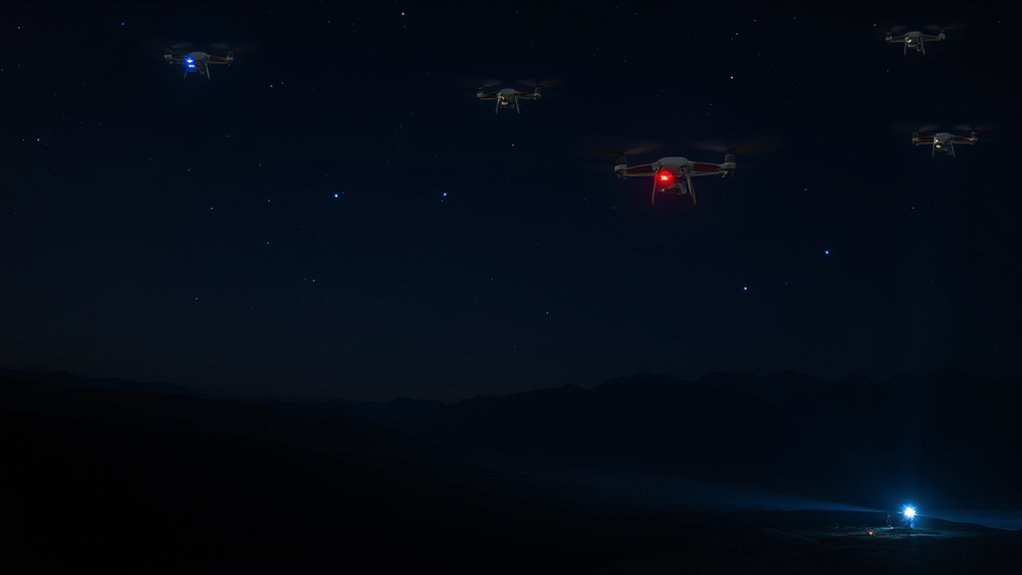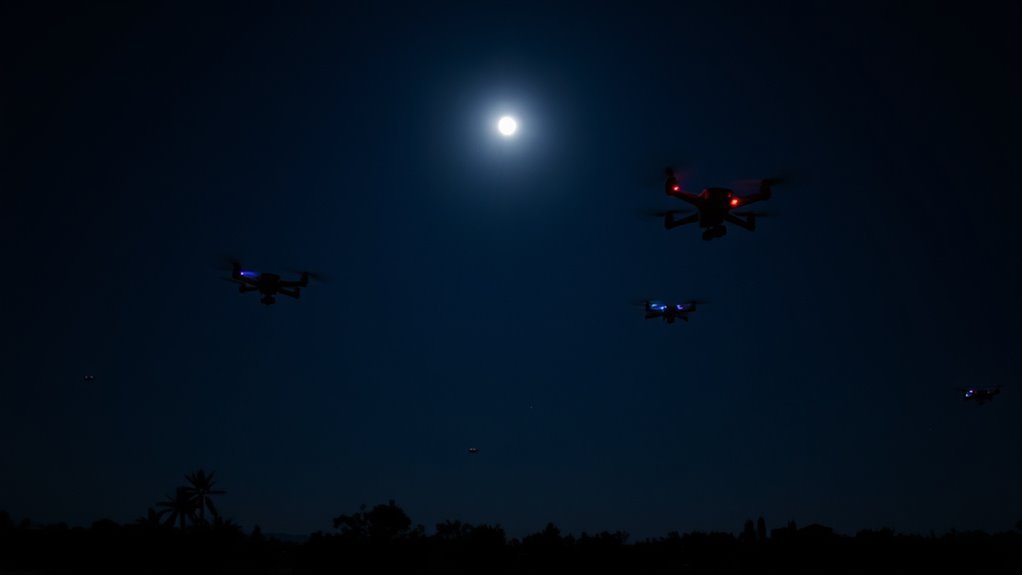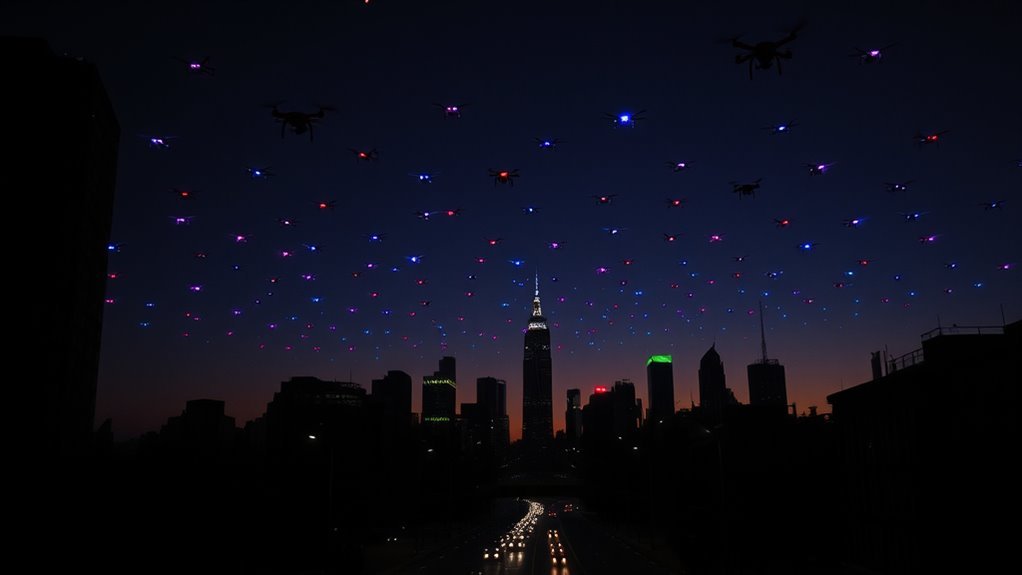Drones are flying at night for several reasons. They enhance surveillance with night vision and thermal imaging capabilities, improving safety and situational awareness. In search and rescue missions, they locate missing persons by detecting body heat and can deliver medical supplies quickly. Nighttime recreational activities, like photography and racing, are also popular. Finally, drones are used for faster nighttime deliveries. If you’re curious about the implications of this nighttime activity, there’s more to explore.
Enhancing Surveillance Capabilities

As technology evolves, the ability to deploy drones for surveillance at night has transformed security operations. Drones equipped with advanced night vision capabilities allow for effective aerial monitoring, ensuring safety and security without compromising individual freedoms. You can now observe large areas under low-light conditions, allowing for proactive responses to potential threats. The integration of infrared and thermal imaging technologies enhances situational awareness, enabling operators to identify and track movements that traditional surveillance methods might miss. This real-time data collection not only improves response times but also empowers communities to maintain their security autonomously. By leveraging these advancements, you’re not just enhancing surveillance capabilities; you’re also reinforcing the balance between safety and personal freedom, fostering a more secure environment for all. The use of drones with superior low-light capabilities can significantly enhance operational freedom in varying conditions, and advanced features like high-resolution imaging can further optimize surveillance efforts.
Search and Rescue Operations After Dark

The capabilities of drones extend beyond surveillance; they play a pivotal role in search and rescue operations conducted after dark. Equipped with thermal imaging technology, drones can detect body heat, allowing emergency responders to locate missing persons in challenging environments. This efficiency drastically reduces the time needed for rescue missions. Additionally, drones enhance situational awareness through real-time data transmission, which supports rapid decision-making during critical operations. Drones can also be deployed in medical supply delivery, ensuring that urgent supplies reach those in need even in the most challenging terrains.
| Feature | Benefit |
|---|---|
| Thermal Imaging | Identifies heat signatures |
| Night Vision Cameras | Enhances visibility in darkness |
| GPS Technology | Pinpoints exact locations |
| Real-time Feedback | Improves decision-making speed |
Using drones in emergency response not only increases safety for rescuers but also gives hope to those in distress. Their swift deployment and advanced capabilities make them indispensable in nighttime operations.
Recreational Drone Use at Night

While many enthusiasts appreciate the thrill of flying drones during the day, recreational drone use at night offers a unique set of challenges and benefits. For one, nighttime photography allows you to capture stunning images illuminated by city lights or natural phenomena, enhancing your creative potential. However, you’ll need to navigate reduced visibility and guarantee your drone is equipped with appropriate lighting. If you’re into drone racing, the night adds an exhilarating dimension, as illuminated drones zip through courses, creating a visual spectacle. Yet, be aware of local regulations regarding nighttime flying; compliance is essential for safety and legality. Ultimately, embracing nighttime drone activities can expand your skills and experiences, making it a thrilling alternative to daytime flying.
Nighttime Delivery Services
Nighttime delivery services are revolutionizing logistics by leveraging drone technology to meet consumer demands more efficiently. As you explore this innovation, consider how drone logistics enhance nighttime efficiency:
- Increased Speed: Drones can bypass traffic, ensuring quicker deliveries. The Amazon MK30 drone, for instance, can reach speeds up to 50 mph, making it particularly effective for last-mile deliveries during nighttime hours.
- Expanded Coverage: Remote areas now have access to essential goods, even after dark.
- Cost-Effective Operations: Reduced labor and transportation costs lead to lower prices for consumers.
- Sustainability: Electric drones contribute to reduced carbon footprints compared to traditional delivery methods.
These factors illustrate how drones are not just a novelty; they’re reshaping how we think about delivery. With the freedom to receive goods at any hour, you’re witnessing a pivotal shift in consumer convenience and operational efficiency. Moreover, advancements in collision avoidance technology enhance safety during nighttime operations, ensuring drones can navigate effectively in low visibility conditions.
Implications for Privacy and Safety
As drones become integral to nighttime delivery services, concerns regarding privacy and safety inevitably arise. You might wonder how these flying devices impact your personal space. Privacy concerns heighten as drones equipped with cameras could potentially capture footage of your property without consent. This intrusion raises ethical questions about surveillance and data collection. Additionally, safety regulations are vital to mitigate risks associated with drone operations, especially at night. Unregulated flights could lead to accidents, interference with emergency services, or collisions with other aircraft. Authorities must implement strict guidelines to guarantee that drone usage doesn’t infringe on your freedoms while maintaining a safe environment. Signal attenuation is a critical factor that can also affect the reliability of drone operations in low visibility conditions. The need for advanced sensors on drones is crucial to ensure safety and effective navigation as we adapt to this evolving technology landscape. Balancing innovation with individual rights is essential as we adapt to this evolving technology landscape.
Frequently Asked Questions
Are There Specific Regulations for Nighttime Drone Flights?
Yes, there’re specific nighttime regulations for drone flights. You’ll need to secure drone permissions, adhere to altitude limits, and guarantee visibility. Understanding these rules helps you navigate the skies responsibly while enjoying your freedom.
What Types of Drones Are Best for Night Flying?
When considering night flying, you’ll want drones equipped with night vision and thermal imaging capabilities. These features enhance visibility, offering you the freedom to explore and capture stunning nocturnal landscapes with precision and clarity.
How Do Drones Navigate in the Dark?
Drones navigate in the dark using night vision cameras and GPS technology. These systems allow you to maintain precise control and awareness of your surroundings, ensuring safe and efficient operation even without visible light.
Can Drones Be Used for Nighttime Wildlife Monitoring?
Yes, drones can be effectively used for nighttime observations and wildlife tracking. Equipped with infrared cameras and advanced sensors, they enhance monitoring capabilities, ensuring accurate data collection while minimizing disturbances to natural habitats and animal behaviors.
What Safety Gear Is Required for Flying Drones at Night?
When flying drones at night, you’ll need night vision equipment and appropriate safety gear, like reflective vests and lights, to guarantee visibility. Proper safety equipment is essential for compliance and minimizing risks in low-light conditions.

